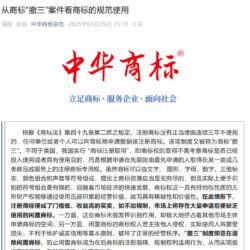1. Strict Standard for Evidence in Trademark Non-use Cases
The term “Cancellation for Non-Use” pertains to a trademark cancellation case initiated by the registered trademark owner due to the absence of valid reasons for not utilizing the trademark. In industry parlance, this is often referred to as a “trademark cancellation for non-use” case. In recent years trademark applications in China are reaching unprecedented levels; however, a considerable number of registered trademarks remain unused in the market, serving primarily as protective registrations for certain companies. Additionally, some individuals are taking advantage of the trademark registration system by hoarding trademarks with the intent to profit from their transfer.
The primary purpose of a trademark is to differentiate various market entities offering goods and services. When a trademark is not actively used in the market, it results in a misallocation of trademark resources. To address this issue and to facilitate the trademark registration process, requests for cancellation—specifically for trademarks that have not been utilized for three consecutive years—are increasingly being made. This trend has contributed to the rise in trademark “cancellation for non-use” cases in recent years. Concurrently, the practice of hoarding registered trademarks and engaging in malicious trademark registrations is becoming more prevalent.
In light of this situation, both the trademark office and courts in China implementing stricter standards for evidence in trademark “cancellation for non-use” cases can effectively help eliminate hoarded and inactive trademarks, thereby promoting the principle of “using trademarks, not speculating.” When responding to applications for trademark “cancellation for non-use,” the trademark owner is required to present evidence of trademark use to the examination authority to uphold the trademark’s validity. This evidence must demonstrate either actual use of the trademark or provide legitimate reasons for its non-use. The trademark adminstrative and judicial authorities will assess this evidence, and if it is found to be valid, the registered trademark will be retained.
Consequently, the critical focus in examining trademark cancellation for non-use cases lies in the evaluation of the evidence of trademark use.
Judge Yuanmei Wu of Beijing Intellectual Property Court shared her views of the judicial assessment of genuine intent of trademark use in non-use cases, which can be summarized as follows.
2. Principles for Judicial Review of Non-use Cases
In cases of trademark non-use, even if the trademark owner asserts that their lack of use is due to justifiable reasons, it is common for some evidence of use to be presented. Therefore, when assessing whether the trademark owner has a “genuine intention to use” the trademark, it is essential to adhere to the review principles.
The core issue in determining the validity of the disputed trademark’s registration lies in the evaluation of the evidence of use submitted by the trademark owner. To maintain trademark registration, the evidence must demonstrate that the trademark has been used in a genuine and effective manner, rather than merely being used symbolically or incidentally to preserve its status. The use of the trademark should exhibit a certain level of consistency and continuity. This requirement results in a rigorous examination of evidence in cases of “cancellation for non-use.”
Typically, the evaluation of evidence will encompass the following aspects:
First, trademark use within the three year timeframe is essential..
Cases involving “cancellation for non-use” typically focus on a three-year timeframe, and demonstrating trademark use within these three years is essential. Some cases select a time period that is significantly in the past, which can pose challenges for small businesses trying to gather evidence. In certain instances, the rights holder may not have proof of use during the designated three-year period and can only present evidence from three years before or after that timeframe. Current practices show that rights holders seldom provide evidence from outside the specified period, and courts also tend to give limited weight to such evidence.
Next, the evidence should show the disputed trademark exactly the same as it registered.
Typically, a rights holder may have several trademarks, some of which may be quite distinct from one another, while others may be closely related to the trademark in question for cancellation. In practice, the identification of a trademark can change over time, and its usage may differ from the status at the time of the original application. If the rights holder’s trademark is not distinctive, the standards for providing evidence become even more rigorous.
Third, the evidence submitted must clearly demonstrate the use of the designated goods.
Trademark usage is specifically linked to designated goods, and in instances of “cancellation for non-use,” the evidence submitted by the involved parties must clearly demonstrate the use of the designated goods. However, it is not uncommon for the actual goods to differ from those that have been approved. Many trademarks facing cancellation are often registered defensively by the rights holder, which contributes to a strong trademark defense strategy by securing trademarks for related or upstream products. As a result, in “cancellation for non-use” cases, the goods that are actively used are usually the primary goods associated with the main trademark, while the goods related to the contested trademark tend to be fewer in number.
Additionally, in China invoices are crucial evidence.
In practice, there are several ways to utilize trademarks, including both direct and licensed uses. Some of these may require payment, while others may not, and transactions can vary in whether they come with invoices. Due to certain challenges within the social credit system, there tends to be a heavy reliance on invoices. When invoices are absent, evidence may be viewed with skepticism, as it could be seen as potentially fabricated. On the other hand, the presence of invoices typically leads to the assumption that the transactions in question have indeed taken place.
Following a thorough examination of the evidence submitted, if any issues or concerns arise, the court will also consider whether the trademark owner demonstrates a “genuine intention to use” the trademark before making a final decision regarding the cancellation of the disputed trademark.
3. Judicial assessment of “Genuine Intention to Use”
According to Article 26 of the Regulations of the Supreme People’s Court on Several Issues Concerning the Trial of Administrative Cases of Trademark Authorization and Confirmation, if a trademark owner demonstrates a genuine intention to use the trademark and has made the necessary preparations for its actual use, but has not yet utilized the registered trademark due to other objective circumstances, the court may recognize the existence of justifiable reasons. This means that to establish “justifiable reasons,” two key criteria must be met: there must be a sincere intention to use the trademark, and there must be adequate preparations for its intended use.
In this context, the term “genuine intention to use” acts as the basis for justifying the trademark owner’s inability to use the registered trademark. Any subjective intent must be assessed through objective actions. For example, when evaluating “malicious registration” as described in the first paragraph of Article 45 of the Trademark Law, various factors can be considered, such as the similarity between the disputed trademark and existing well-known trademarks, the distinctiveness and reputation of those trademarks, their connection to the goods, and any business interactions or partnerships between the parties involved. Additionally, when determining whether a malicious registrant is aware or should be aware that the trademark is not registered by others, factors may include whether the applicant for the disputed trademark has contacted the prior trademark user regarding licensing or transfer, whether the applicant has engaged in trademark infringement, whether both parties operate within the same industry, and whether the prior trademark is highly distinctive while the disputed trademark closely resembles it.
While the notion of “genuine intention to use” may seem flexible and open to personal interpretation, it is essential that it aligns with specific objective criteria.
4. How effectively demonstrating “Genuine Intention to Use” the trademark
In administrative trademark cancellation cases, trademark owners with less compelling evidence often claim to have a “genuine intention to use” their trademarks.
Conversely, those with stronger evidence may also reference this intention to support their claims. However, when actual use evidence is absent, courts tend to view the trademark owner’s “genuine intention to use” with skepticism, often concluding that sufficient evidence has not been provided. So, how can a trademark owner effectively demonstrate their “genuine intention to use” the trademark?
To begin with, “genuine intention to use” must be substantiated through external factors. As previously mentioned, since this is a subjective state, proof of “genuine intention to use” should be reflected in objective actions. Due to the lack of evidence for actual use, trademark owners frequently assert a “genuine intention to use.” However, external evidence does not equate to evidence of use itself; rather, it relies on “justifiable reasons” for non-use. Therefore, when evaluating whether a contested trademark should be revoked, it is essential to consider the specific circumstances surrounding these “justifiable reasons.”
According to Article 20 of the Opinions of the Supreme People’s Court on Several Issues Concerning the Trial of Administrative Cases of Trademark Authorization and Confirmation, if a trademark owner has been unable to use the registered trademark or has stopped using it due to objective factors such as force majeure, policy restrictions, or bankruptcy liquidation, or if they have a genuine intention to use the trademark and have made necessary preparations for actual use but have not yet done so for other objective reasons, this can be recognized as having justifiable reasons. The specific circumstances mentioned include force majeure, policy restrictions, and bankruptcy liquidation, among others.
Moreover, the concept of “genuine intention to use” can be further understood by examining the specific context in which the trademark is utilized.
Commercial activities are complex and adaptable, influenced by factors such as product characteristics, business locations, and consumer behaviors. Trademark usage may vary slightly depending on the commercial context. Article 20 of the aforementioned opinions states that if the actual use of a trademark differs slightly from the registered version but retains its distinctive features, it can still be considered valid use. For trademark owners with only one contested trademark, there is generally more leniency for minor differences, provided the public can recognize it as the registered trademark. However, for those with multiple registered trademarks, this leniency diminishes. If the actual trademark used shows slight differences but is aimed at other registered trademarks, the claim to maintain the contested trademark may not be upheld. An example of valid trademark use is when the owner uses products with the contested trademark exclusively for export.
Additionally, the use of trademarks in online environments is noteworthy.
In a cancellation review concerning “Double Eleven,” the court found that “Double Eleven,” a service brand for a major promotional event organized by a third party, had received significant advertising and promotion for the contested trademark during the relevant period. The third party’s ongoing promotion helped the contested trademark gain commercial recognition and industry influence. The third party engaged platform merchants through various promotional activities and established a dedicated “Double Eleven” event space on the platform, labeling participating merchants and products with “Double Eleven” to provide product information, identify sources, and categorize items. Consumers could easily access information about participating merchants and products through the event space and the “Double Eleven” labels. In this commercial context, the use of “Double Eleven” and “Double 11” exemplifies typical trademark usage in the online service environment. Despite some differences between the two terms, the court recognizes the third party’s genuine intention to use the trademark and notes that “Double Eleven” and “Double 11” are identical in pronunciation and meaning. The relevant public is accustomed to associating “Double 11” with “Double Eleven.” The court concludes that the third party’s usage aligns with commercial practices and public perception, thus constituting valid use that does not alter the distinctive characteristics of the contested trademark.
In conclusion, it is essential to assess the “genuine intention to use” a trademark in conjunction with the objectives of the three-year non-use cancellation system.
The effectiveness of a trademark as a commercial identifier is closely linked to its active use in connection with goods, rather than being held without purpose for an extended duration. The three-year non-use cancellation system in trademark law aims to encourage registered trademark holders to actively utilize their trademarks and fulfill their role in the marketplace. This usage should be both consistent and authentic; however, evaluating the usage of trademarks facing cancellation, especially those involved in litigation, can be complex. When a trademark’s exclusive rights holder presents initial evidence demonstrating use of the contested trademark within the specified timeframe, they should be considered to have satisfied their proof requirement unless contrary evidence is presented. Furthermore, to foster active use among trademark holders, a genuine intention to use the trademark should not hinder its identifying and distinguishing functions.
Conclusion
The three-year non-use cancellation system was designed to promote the active use of trademarks by allowing for cancellation. However, the revised trademark law in 2013 permits trademark owners to retain their registrations even if they have not used them for three years, provided they can offer valid justifications. This amendment reinforces the legislative intent and introduces protections to ensure trademark stability while deterring malicious cancellation attempts. It is believed that as long as trademark owners diligently manage their trademarks and maintain proper documentation, they should not be concerned about facing cancellation after three years.


